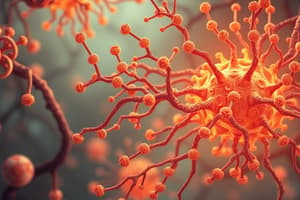Podcast
Questions and Answers
Which brain circuit is primarily affected by drugs of abuse, leading to reinforcement of drug-taking behavior?
Which brain circuit is primarily affected by drugs of abuse, leading to reinforcement of drug-taking behavior?
- Motor cortex
- Sensory cortex
- Hippocampus
- Reward circuitry (correct)
Which of the following is NOT an effect of chronic drug use on the brain's stress systems?
Which of the following is NOT an effect of chronic drug use on the brain's stress systems?
- Negative emotions during withdrawal
- Dysregulation of the HPA axis
- Increased sensitivity to stress
- Enhanced emotional regulation (correct)
How does understanding addiction as a brain disease impact treatment approaches?
How does understanding addiction as a brain disease impact treatment approaches?
- It eliminates the need for medication.
- It highlights the importance of medical interventions alongside behavioral therapies. (correct)
- It emphasizes the need for behavioral therapies only.
- It suggests addiction is solely a personal choice.
What is one of the key public policy implications arising from the brain disease model of addiction?
What is one of the key public policy implications arising from the brain disease model of addiction?
What is the primary focus of the article "A Clinical Review of the Diagnosis, Treatment, and Prevention of Opioid-Related Harms"?
What is the primary focus of the article "A Clinical Review of the Diagnosis, Treatment, and Prevention of Opioid-Related Harms"?
Which of the following is NOT a key factor contributing to the opioid crisis in North America, according to the article by Zivanovic, Wood, & Nolan (2016)?
Which of the following is NOT a key factor contributing to the opioid crisis in North America, according to the article by Zivanovic, Wood, & Nolan (2016)?
Which statement best describes the link between chronic drug use and executive function?
Which statement best describes the link between chronic drug use and executive function?
What is the significance of the brain disease model of addiction for public policy?
What is the significance of the brain disease model of addiction for public policy?
Flashcards
Addiction as a Brain Disease
Addiction as a Brain Disease
Addiction is a chronic brain disorder characterized by compulsive substance use despite harmful consequences.
Compulsive Substance Use
Compulsive Substance Use
Engaging in substance use despite awareness of its harmful effects, driven by brain changes.
Reward Circuitry
Reward Circuitry
Brain pathways that increase dopamine levels, reinforcing drug-taking behavior.
Chronic Drug Use Effects
Chronic Drug Use Effects
Signup and view all the flashcards
Executive Function Impairment
Executive Function Impairment
Signup and view all the flashcards
Medical Interventions for Addiction
Medical Interventions for Addiction
Signup and view all the flashcards
Stigma Reduction in Addiction
Stigma Reduction in Addiction
Signup and view all the flashcards
Neurobiological Research in Addiction
Neurobiological Research in Addiction
Signup and view all the flashcards
Study Notes
Neurobiological Advances in Addiction
- Addiction is a chronic brain disease characterized by compulsive substance use despite harmful consequences.
- Chronic substance use alters brain circuits involved in reward, stress, and self-control, contributing to compulsion.
- Reward circuitry: Drugs increase dopamine, reinforcing drug-taking behavior.
- Stress systems: Chronic drug use dysregulates stress systems, leading to increased stress sensitivity and negative emotions during withdrawal.
- Executive function: Impairments in the prefrontal cortex affect decision-making and impulse control, making it difficult to resist cravings.
Implications for Treatment
- Understanding addiction as a brain disease emphasizes the need for medical interventions alongside behavioral therapies.
- Advances in neurobiology have led to medications targeting addiction, reducing cravings or normalizing brain function.
Public Policy Considerations
- Recognizing addiction as a brain disorder reduces stigma and supports treatment over punishment.
- Investment in research and healthcare infrastructure is essential for effective addiction treatment.
- Continued research into the neurobiology of addiction will enhance prevention and treatment strategies and improve patient outcomes.
Opioid-Related Harms (Diagnosis, Treatment, and Prevention)
- Opioid-related health crisis in North America (especially Canada), attributed to both prescription and illicit opioid use (e.g., fentanyl).
- Key signs of opioid overdose: decreased respiratory rate (<12 breaths per minute), depressed mental status, and constricted pupils (miosis).
- Differential diagnoses: stroke, sepsis, metabolic disturbances, & co-ingestion.
- Diagnostic investigations: basic hematologic and electrolyte profiles, serum glucose and creatinine kinase, and screening for co-ingestants (acetaminophen, salicylates, alcohol).
- Urine drug screens are helpful but not always required.
- Treatment of opioid overdose: initial stabilization with respiratory support (including ventilation if needed), naloxone (antidote), and close monitoring of vital signs.
- Naloxone, administered parenterally, start at 0.04 mg and titrate upward; repeated doses or continuous infusions may be necessary.
- Close monitoring of vital signs and consciousness levels is essential.
Prevention Strategies
- Supervised Injection Facilities (e.g., Insite in Vancouver): provide sterile injection equipment, supervision, and reduce overdose deaths, improving cost-effectiveness of public health.
- Physician Education: enhance knowledge on safe opioid prescribing (avoiding overlapping/long-term prescriptions, utilizing opioid agreements/contracts, monitoring for signs of misuse, avoiding co-prescription with sedatives).
Policy Recommendations
- Collaborative action among policymakers, clinicians, and regulatory bodies to implement harm reduction programs for opioid-related deaths.
Combined Treatment for Substance Use Disorders
- Combining CBT with pharmacotherapy is more effective than usual care with pharmacotherapy for treating SUDs.
- Combined treatment did not show superior outcomes over other evidence-based therapies (i.e., motivational enhancement therapy, contingency management).
- Introducing CBT into standard care alongside pharmacotherapy yielded mixed results, indicating variability in its added benefit.
- Research included 30 randomized clinical trials with 62 effect sizes, analyzing alcohol (50%), cocaine (23%), and opioid (20%) dependence cases.
- Average participant age: 39 years; 28% female.
- Naltrexone, acamprosate, methadone or combination buprenorphine and naltrexone were the pharmacotherapies utilized.
- Disulfiram and other/mixed pharmacotherapies: utilized in 8% and 32% respectively.
Studying That Suits You
Use AI to generate personalized quizzes and flashcards to suit your learning preferences.




